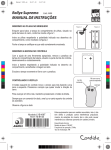Download the definitive opel gt guide for year, color and parts
Transcript
THE DEFINITIVE OPEL GT GUIDE FOR YEAR, COLOR AND PARTS IDENTIFICATION This has been a common question on the mailing list and for most Opel GT owners for years. One explanation for this trouble was the difference between the European model year and the American model year in years past. The European model year ran from January to January, while the American model year ran from September to September. The tactic of introducing your company’s “New” model year early eventually influenced the Europeans and now everyone does it. Of course we can now see new models show up as early as Mid-April, but that’s another story altogether. The other reason or excuse that has been kicked around is that Opel was trying to build the GT to sell at a fair price. To do this with all the extra labor it took to put the GT together required cost-cutting measures. So when Opel redesigned a component on the GT they would first use up all the old components before they made the change. That’s why differences in model years cross over. Or perhaps Opel or the assembly plant workers were just plain lazy. In any case, it has become somewhat difficult to distinguish between the different model years. 1968 – Yes Virginia, there is a ‘68 GT. But it is VERY RARE, most records indicate that only approximately 121 of them were ever built and only 31 were imported into the US. These were first-run vehicles that were sent to special dealers as promotional tools. Because the GT was a custom Kaddett in many ways, at this stage they were still working out the bugs and were hand building them. This causes you to find a few very unique items on a ‘68, which can be dead giveaways. With that said, it should be noted that you still have to remove the dash and look at the back of the gauges to be certain of the month and year of production. Early 1969 Models (anything built after August of 68), can have a few of these clues, if not all of them, but true 68s’ were only built prior to 8/68, anything else is close but no cookie. Also note that all ‘68s were 1.9L – 4speeds, if the car has a 1.1L or an Automatic it cannot be a ‘68. Starting Chassis # : Unknown Production Numbers: Records indicate that only 31 were imported into the US, 121 total were built. Some records, however, show a total production of 541. It’s possible that the numbers are more like 541 produced in the year 1968 with 121 built prior to August 1968. Also conflicting is the fact that I have read old internal Opel documents which mentioned that all ‘68 GTs were only of the 1.9L variety. BUT, the records that indicated the higher 541 production number indicate there were 12 - 1.1L versions. All this makes the confirmation of the build date that much more important. While a finding a ‘68 GT would indeed be rare, confirming a 1.1L ‘68 would be this side of finding a Convertible AAR Plymouth ‘Cuda. Note that even if the GT fits ALL of these criteria, what looks like a ‘68 could still be an early ‘69. I recently “Un-confirmed” a ‘68 GT that was VERY close, it had a split bumper, flat back panel, “H” head, No A.I.R. emissions, no W on the speedometer and in every way seemed to be a ‘68. BUT, the build date on the speedo and ammeter was 11/68, making it a VERY early ‘69. It was probably hand-built like the 68s’, and to the unknowing could have been one but, alas, it wasn’t. Unique Color Combinations or Trim: Unknown (Assume they are the same as ‘69) – One confirmed ‘68 had a silver exterior and a red interior, one other was red and black. Differences: • • • • • • • • • • • 1.9L “H” head (It’s a 1.5L Head with 1.9L valves – Results in about a 0.5:1 compression increase over any other 1.9L ) (SOME Very early ‘69s also had this head and did not come with the A.I.R. emissions system) “Split” front bumper (Front bumper is a two-piece design meeting in the middle) Tail Panel is flat (no indentation for license plate) Speedometer face WITHOUT “W” (897,1062) calibration number. Dash Gauges have a wider chrome ring face Air Filter lid on Solex has red paint on the part numbers. Spare tire wood shelf has an access hole for the fuel gauge sending unit. Spare tire hold-down bracket has a “Square” wing-nut Heater Valve is located INSIDE the car. Rear view mirror is wider than later models. Sun visors have a different shape. THE DEFINITIVE OPEL GT GUIDE FOR YEAR, COLOR AND PARTS IDENTIFICATION – CONT. 1969 – The first official model year of the GT. This was also the GT’s best selling year as far as orders received, although a lot of orders were filled in the ‘70 model year. This is also the year (along with the ‘68s) which had the most parts that differed from later years. Starting Chassis # : 94-1535504 Some Early ‘70 models (up to approximately Chassis #94-1925379) have some of these traits as well. Production Numbers : (These numbers vary due to differences in overall production, US imports, and US sales numbers) Overall production: 34,997 1.1L versions: 3,523 1.9L versions: 31,474 U.S. Sales: 11,880 Unique Color Combinations or Trim: British racing green with a light buckskin interior, silver with a red interior (also seen on one of the confirmed ‘68 GTs) Differences: • • • • • • • • • • • • • • • • • • • • • • Dealer installed A.R.A. air conditioning first offered Rectangular dash indicator lights above steering wheel in dash. Dash wiring and some of the headlight wiring is totally different, if you have a ‘69 you NEED to use the ‘69 wiring diagram. The Standard 7173 wiring diagram is quite different due to this fact. Button on end of turn signal stalk (for High Beams) Window Crank is 6” from bottom of driver door (same as the passenger door) Driver window crank assembly pulley is 3-7/8” in diameter with 81.5” cable (part number 140-422) Passenger window crank assembly crank pulley is also 3-7/8” in diameter but w/ 82” cable (part number 140-423) Shoulder belt is mounted just below side quarter window A.I.R. emissions system on engine (air pump, extra hoses, etc.) (This came into existence after 1/69) Larger temperature sender on thermostat housing Single retainer bracket on underside of hood Wiper arm on driver’s side without metal wing Suspension parts are narrower: inner tie rods, cross member Steering coupler uses a metal flex plate (Not rubber) Headlight mechanism has an additional microswitch Throttle rod is shorter on left side of engine Ashtray lid is hinged with a vinyl cover Cigarette lighter and dash mount is narrower Highlight lever is thinner, squared off plastic Carpet piece under E-brake handle Car Jack has a spherical “ball” red handle “GM” Logo behind rear window, 1900 or 1100 designation on rear panel, “Opel GT” insignia on front fender (these logos also appear on ‘68 and 70 Models as well) THE DEFINITIVE OPEL GT GUIDE FOR YEAR, COLOR AND PARTS IDENTIFICATION – CONT. 1970 – This year is a bit different; it’s a transition year. There was a lot of confusion with the new Federal regulations which caused some ‘69 models to be held up at the factory for emission reasons, and then sold as ‘70s, without the A.I.R. system. So some early ‘70s look like and fit all the ‘69 parameters (right down to the wiring diagram). While the late ‘70 cars have a lot of drive train differences from the transmission to the rear end. Also, this was the last year for the 1.1L drive train. Starting Chassis # : 94-1888818 Early ‘70 chassis end around chassis #94-1925379. These cars are more in line with the ‘69 than the ‘70 as far as components go. Also take note that the numbers are not in sequence. It seems that the GT and Kaddett shared the final 7 digits of the chassis number so the sequential numbers of the GT and Kaddett are intertwined. Thus adding 34,997 to the 1535504 number doesn’t give you the starting chassis number of the ‘70, which is 94-1888818 or 353,314 units (if it were in series). Production Numbers : (The numbers vary due to differences in overall production, US imports, and US sales numbers) Overall production: 24,342 1.1L versions: 38 (though I have seen higher numbers) 1.9L versions: 24,304 U.S. Sales: 21,240 (The US Sales number seems high, and it is assumed that this probably includes a good number of late ‘69 models being sold as ‘70s) Unique Color Combinations or Trim: Last year for red interior, offered in white instead of silver. Silver was discontinued due to quality problems in ‘69. Differences: • • • • • • • • • • • • • • • GM (Frigidaire) air conditioning offered, dealer installed OR factory installed. Rubber rimmed steering wheel, (Was only put in the middle ‘70 versions. Towards the latter part of the 1970 model year they reverted to the “wood” grained version) Date code and chassis number on left door latch area. Round dash indicator light lenses on dash plate (From ~Chassis #94-1925380) (This change also includes a change in the wiring to the standard ‘71-‘73 wiring diagram, although the ‘70 service manual shows the older wiring diagram, so be careful if you have a ‘70 with this change - get the ‘71 wiring diagram) Cigarette lighter size changes (Coincides with round indicator lights and wiring changes) Ignition lock cylinder changes to BB code (Coincides with round indicator lights and wiring changes) Light lens in dash panel above switch bank (Coincides with round indicator lights and wiring changes) Turn signal ring is hinged ( High beams are activated by pulling stalk back – also coincides with indicator light and wiring changes) Window crank is 12” from bottom of driver door (From Chassis number #94-1925380 to #94-2265861) (6” higher than Passenger door) Driver window crank assembly pulley is 3-7/8” in diameter w/ 80” cable (part number 140-430) Passenger window crank assembly same as ‘69 for entire ‘70 model year (part number 140-423) Evaporative canister in belly pan next to battery (the evaporative system replaced the A.I.R. smog pump) Plastic tray underneath the E-brake. Rear axle design change (From Chassis #94-2264500) Transmission change (synchros, speedo gear location - From Chassis #94-2264500) 1971 – Major changes this year, some were actually integrated (like the rear end and transmission) in the late ‘70 models. The engine was a major change. For emission reasons, the engine was de-tuned and had the compression dropped from 9:1 to 7.3:1, causing a loss of over 20 HP and effectively taking a lot of the spunk out of the GT and its sales. This year also coincided with the introduction of the Datsun 240Z (now Nissan) which didn’t help matters at all, especially since the “Z” was cheaper than the GT and had an in-line 6 cylinder engine. My personal belief is that if Opel had really been behind the GT, the GT’s engine would have been increased in power and not stripped of it, the engineering to make it more powerful and emissions friendly at the same time was there. The only problem is that GM didn’t want to dedicate the time and effort. Interestingly, Opel and Buick did devote a lot of money into the promotion of the car. In the memorabilia market for the GT, a lot of dealer literature and promotional items can be found for the GT dating back to this model year and this model year ONLY (Although promotional models were available for the ‘69 (red) and ‘70(green) model year). In typical GM fashion they felt promotion of an inferior product was the key to sales, instead of actually spending time on making the product better. Can we believe that a more powerful 1.9L (or possibly a 2.2L) fitted into the GT and Manta Rallye Models would have helped sales to the point of actually keeping the GT and Opel in The US? Starting Chassis # : 77-2265862 THE DEFINITIVE OPEL GT GUIDE FOR YEAR, COLOR AND PARTS IDENTIFICATION – CONT. 1971- (Cont.) Production Numbers : Overall production: 14,715 U.S. Sales: 13,696 Production numbers include a European ONLY version called the GT/J. The GT/J was a stripped down version with rubber floor mats and a few other “economy” items to make the car cheaper in Europe where sales were down to almost nothing. Differences: • • • • • • • • • • • • • • • Model number changed from 94 to 77 “GM” logo under rear window deleted “1900” logo under gas cap deleted “Opel GT” logo moved from front fender to rear of car (Above license plate) Side rear quarter windows “pop-out” for ventilation. Cylinder Head goes from 3 bearing design to 4 bearing design Cylinder Head goes from solid lifters to hydraulic lifters Note: the ‘71 and early ‘72 head did not have the extra Allen bolt holes in the front of the head, although they were cast to be able to be drilled for them. This head is the preferred head to rebuild, since it is less prone to warping or cracking than any of the other 1.9L heads, except the rare ‘68 “H” head. Stock Rims changed to “15-hole” design Instrument panel face held in with 7 screws 35 amp alternator option with rear window defroster Parking light indicator (red light) on dash face plate Intake manifold has taller carburetor mounting studs. Shoulder belt mounts on posts near door. Driver window crank changed to 3” in diameter w/ 75.5” cable (part number 140-431) – Crank handle 12” from bottom of door Passenger window crank changed to 3” diameter w/755” cable (part number 140-432) – Crank handle 6” from bottom of door 1972 – This was by far the most stable of years. There are very few and very subtle changes from the ‘71. Some have said this is the best year for the GT. Most of the bugs were worked out, workmanship was at its peak and it doesn’t have some of the more undesirable changes that were introduced in the ‘73 model year. Also, there was a subtle change to the bushings in the control arms that made a noticeable difference in the handling. Starting Chassis # : 77-2560567 Production Numbers : Overall production: 17,389 U.S. Sales: 12,055 (The introduction and acceptance of the GT/J by the European community, and resurgence of the European car market helped boost sales in Europe) Differences: • • • • • • • • • • • • • • • • Writing on interior buttons, heater and headlight lever Clock manufacturer changed to Borg Engine Dipstick goes into the block and not into a dipstick tube Starter Manufacturer changed from Bosch to Delco Stock alternator changed from 30amp to 35amp. Air filter canister top lid narrowed, grille deleted Engine oil pan changed to steel with center drain plug 3-point seat belt configuration introduced Ignition lock cylinder and key changed to “CC” code. Lower control arm bushing inner sleeve widened Heater side ducts connected with rubber vent hoses Door glass mounted with round plastic plugs Rear axle on early ‘72 Models include rear sway bar mounts on housing Rear brake shoes and cable changed to a stirrup / hook end. (late ‘72) Thermostat changed to a 2-bolt design (late ‘72) Head and timing cover changed to have two Allen bolts in the front to help keep head from warping. This redesign of the head caused it to be weaker and these (late ‘72) and the ‘73 heads leaving them prone to cracking THE DEFINITIVE OPEL GT GUIDE FOR YEAR, COLOR AND PARTS IDENTIFICATION – CONT. 1973 – The final year for the GT. This year included a few changes that were brought on for the sake of Opel’s own convenience. Towards the end of the ‘72 model year Opel was running out of GT taillight lenses and the Manta was in production. So instead of spending the money to get Hella to tool up and produce a few more tail light lenses, the decision was made to use Manta taillights instead of the traditional taillight lenses. This caused a few minor differences in the wiring in the back end of the GT and the removal of the back-up lens from under the license plate. They also seemed to want to “connect” the sporty GT with the Manta as well, since they had rims made for the GT that matched the look of the Manta Rallye. Starting Chassis # : OY0NC2944586 Production Numbers : Overall production: 11,380 U.S. Sales: 11,693 (The US Sales number seems wrong, and it is assumed that this probably includes a good number of late ‘72 models being sold as ‘73s) Unique Color Combinations or Trim: The return of the buckskin interior and green body color, although the color of the “Buckskin” is a bit lighter than the original ‘69 color scheme. Differences: • • • • • • • • • • • V.I.N. number begins with “OY0” Rear lenses same as the Opel Manta (after 1/1/73) EGR valve system from exhaust to intake manifolds Solex Carburetor has an electric choke Intake manifold has a vacuum fitting on engine side Engine cross-member protecting plates near mounts Gas tank has an extra vent hose to a 3-hose fuel filter Clutch arm has a plastic plug to hold return spring. Seatbelt connects to stiff plastic buckle Door pull handle has a plastic (not metal) bezel. Rear back-up housing and lens deleted (after 1/1/73) 1974 – It doesn’t exist. But technically in the US it did, sort of. What happened was that Opel built GTs up to approximately October of 1973, which technically (by US standards) made them 74’ Models. Due to importation laws they were still allowed to be imported as ‘73 models since they were made to fill outstanding dealer orders from the ‘73 model year. Dealers on the other hand did at times title them as 74’ Opel GTs, from all the research I have done I have confirmed about five 74’ GTs that were titled that way. But seeing the difference in production numbers and US Sales numbers of the ‘73 model year, one can assume that there may be as many as 100-300 Opel GTs that were mis-titled as 74’ Models. Final comments It should be noted that most GTs have had parts swapped from one GT to another which can skew things a bit. Especially when it comes to trying to use these guidelines to confirm a GT’s year and build. The best indicator is the V.I.N. number, working back from there to confirm what is and isn’t original to the car. Also I would like to give great thanks to Dave Altenberg and the OMC for their original article on the subject in their November 1995 Newsletter, from which I was able to gather some information for this article. Other thanks go to Nathan Acree, Tom and Tobbie Thevenin (of Opel Parts and Service), Adam Opel A.G. (Production numbers), Buick Public Relations (US Sales numbers), and all the others that have helped me with information for this article. Any additional notes or corrections will be gladly accepted for future newsletters.


















